|
Tizen Native API
7.0
|
In this example, we illustrate how to stack objects in a custom manner and how to deal with layers.
We have three objects of interest in it -- white background, red rectangle, green rectangle and blue rectangle.
d.bg = evas_object_rectangle_add(d.canvas); evas_object_name_set(d.bg, "background"); /* white bg */ evas_object_color_set(d.bg, 255, 255, 255, 255); evas_object_move(d.bg, 0, 0); evas_object_resize(d.bg, WIDTH, HEIGHT); d.rects[2] = evas_object_rectangle_add(d.canvas); evas_object_name_set(d.rects[2], "blue"); evas_object_color_set(d.rects[2], 0, 0, 255, 255); evas_object_resize(d.rects[2], WIDTH / 2.2, WIDTH / 2.2); evas_object_move(d.rects[2], WIDTH / 6, WIDTH / 4.5); evas_object_show(d.rects[2]); evas_object_event_callback_add( d.rects[2], EVAS_CALLBACK_MOUSE_DOWN, _on_mouse_down, NULL); d.rects[1] = evas_object_rectangle_add(d.canvas); evas_object_name_set(d.rects[1], "green"); evas_object_color_set(d.rects[1], 0, 255, 0, 255); evas_object_resize(d.rects[1], WIDTH / 2.2, WIDTH / 2.2); evas_object_move(d.rects[1], WIDTH / 2.5, WIDTH / 7); evas_object_show(d.rects[1]); evas_object_event_callback_add( d.rects[1], EVAS_CALLBACK_MOUSE_DOWN, _on_mouse_down, NULL); d.rects[0] = evas_object_rectangle_add(d.canvas); evas_object_name_set(d.rects[0], "red"); evas_object_color_set(d.rects[0], 255, 0, 0, 255); evas_object_resize(d.rects[0], WIDTH / 2.2, WIDTH / 2.2); evas_object_move(d.rects[0], WIDTH / 3, WIDTH / 2.5); evas_object_show(d.rects[0]);
static const char *commands = \ "commands are:\n" "\tc - change the target rectangle to operate on\n" "\ta - stack target rectangle one level above\n" "\tb - stack target rectangle one level below\n" "\tt - stack target rectangle up to the top of its layer\n" "\tm - stack target rectangle down to the bottom of its layer\n" "\tp - toggle target rectangle's 'pass events' property\n" "\tr - toggle target rectangle's 'repeat events' property\n" "\ts - print current stacking information\n" "\tl - change background rectangle's layer\n" "\th - print help\n";
evas_object_stack_below(d.rects[d.cur_rect], neighbour);
evas_object_stack_above(d.rects[d.cur_rect], neighbour);
evas_object_raise(d.rects[d.cur_rect]); evas_object_lower(d.rects[d.cur_rect]);
Let's make some tests with those commands. The rectangle which starts selected and which will receive our commands is the red one. It starts stacked above all the others, like seem above:
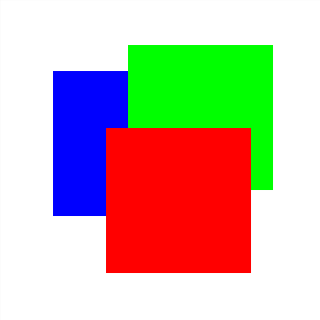
Stack it one level below, with 'b', and you'll get:
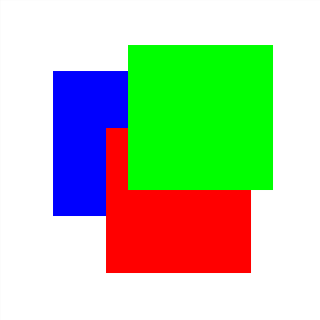
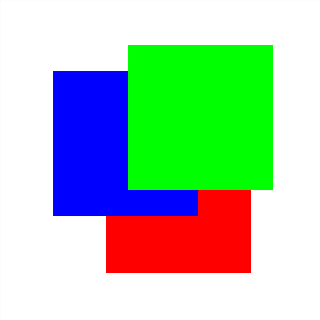
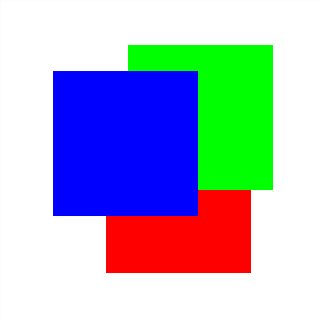
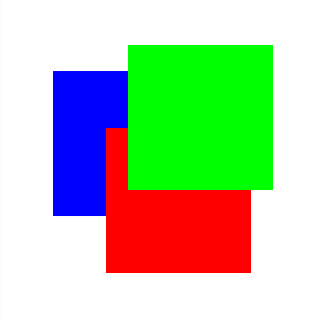

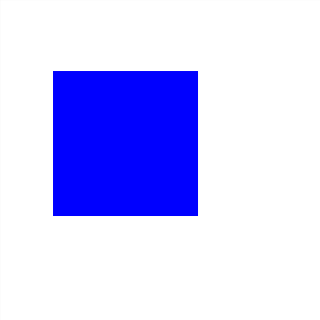
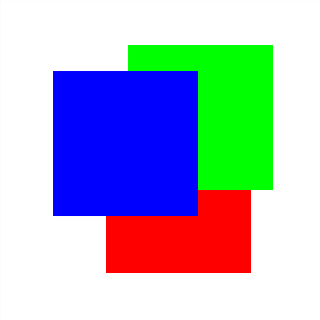
The last two commands available are "p" and "r", which will make the target rectangle to pass (ignore) and repeat the mouse events occurring on it (the commands will cycle through on and off states). This is demonstrated with the following #EVAS_CALLBACK_MOUSE_DOWN callback, registered on each of the colored rectangles:
static void _on_mouse_down(void *data EINA_UNUSED, Evas *evas EINA_UNUSED, Evas_Object *o, void *einfo EINA_UNUSED) { printf("Mouse down on rectangle %s!\n", _name_get(o)); }
The full example follows.
#ifdef HAVE_CONFIG_H #include "config.h" #else #define PACKAGE_EXAMPLES_DIR "." #endif #include <Ecore.h> #include <Ecore_Evas.h> #include <stdlib.h> #include <stdio.h> #include <string.h> #define WIDTH 320 #define HEIGHT 320 struct test_data { Ecore_Evas *ee; Evas *canvas; Evas_Object *bg; Evas_Object *rects[3]; /* red, green, blue */ int layers[3]; /* default, below it, above it */ int cur_rect, cur_layer; }; static struct test_data d = {0}; static const char *commands = \ "commands are:\n" "\tc - change the target rectangle to operate on\n" "\ta - stack target rectangle one level above\n" "\tb - stack target rectangle one level below\n" "\tt - stack target rectangle up to the top of its layer\n" "\tm - stack target rectangle down to the bottom of its layer\n" "\tp - toggle target rectangle's 'pass events' property\n" "\tr - toggle target rectangle's 'repeat events' property\n" "\ts - print current stacking information\n" "\tl - change background rectangle's layer\n" "\th - print help\n"; static const char * _name_get(Evas_Object *o) { const char *s = evas_object_name_get(o); if (!s) s = "(null)"; return s; } static void _on_mouse_down(void *data EINA_UNUSED, Evas *evas EINA_UNUSED, Evas_Object *o, void *einfo EINA_UNUSED) { printf("Mouse down on rectangle %s!\n", _name_get(o)); } /* Keep the example's window size in sync with the background image's size */ static void _canvas_resize_cb(Ecore_Evas *ee) { int w, h; ecore_evas_geometry_get(ee, NULL, NULL, &w, &h); evas_object_resize(d.bg, w, h); } /* use the following commands to interact with this example - 'h' is * the key for help */ static void _on_keydown(void *data EINA_UNUSED, Evas *evas EINA_UNUSED, Evas_Object *o EINA_UNUSED, void *einfo) { Evas_Event_Key_Down *ev = einfo; const char *name = _name_get(d.rects[d.cur_rect]); if (strcmp(ev->key, "h") == 0) /* print help */ { printf("%s\n", commands); return; } if (strcmp(ev->key, "s") == 0) /* get status of the * rectangles WRT size * hints */ { Evas_Object *rect; printf("Order of stacking, from top to bottom, is: "); rect = evas_object_top_get(evas); printf("%s", _name_get(rect)); rect = evas_object_below_get(rect); while (rect) { printf(", %s", _name_get(rect)); rect = evas_object_below_get(rect); } printf(".\n"); printf("Current target rectangle is %s\n", _name_get(d.rects[d.cur_rect])); printf("Background rectangle's layer is %d\n", evas_object_layer_get(d.bg)); return; } if (strcmp(ev->key, "l") == 0) /* change background rectangle's layer */ { d.cur_layer = (d.cur_layer + 1) % 3; evas_object_layer_set(d.bg, d.layers[d.cur_layer]); printf("Changing background rectangle's layer to %d\n", d.layers[d.cur_layer]); return; } if (strcmp(ev->key, "c") == 0) /* change rectangle to operate on */ { d.cur_rect = (d.cur_rect + 1) % 3; printf("Changing target rectangle to the %s one\n", _name_get(d.rects[d.cur_rect])); return; } if (strcmp(ev->key, "t") == 0) /* bring target to top */ { Evas_Object *neighbour; evas_object_raise(d.rects[d.cur_rect]); printf("%s rectangle was re-stacked to the top if its layer\n", name); neighbour = evas_object_below_get(d.rects[d.cur_rect]); printf("Below of %s rect is %s\n", name, neighbour ? _name_get(neighbour) : "no object"); return; } if (strcmp(ev->key, "m") == 0) /* bring target to bottom */ { Evas_Object *neighbour; evas_object_lower(d.rects[d.cur_rect]); printf("%s rectangle was re-stacked to the bottom if its layer\n", name); neighbour = evas_object_below_get(d.rects[d.cur_rect]); printf("Below of %s rect is %s\n", name, neighbour ? _name_get(neighbour) : "no object"); return; } if (strcmp(ev->key, "p") == 0) /* toggle pass events */ { Eina_Bool pass = evas_object_pass_events_get(d.rects[d.cur_rect]); evas_object_pass_events_set(d.rects[d.cur_rect], !pass); printf("%s rectangle is now set to%s pass (ignore) events\n", name, pass ? " NOT" : ""); return; } if (strcmp(ev->key, "r") == 0) /* toggle repeat events */ { Eina_Bool repeat = evas_object_repeat_events_get(d.rects[d.cur_rect]); evas_object_repeat_events_set(d.rects[d.cur_rect], !repeat); printf("%s rectangle is now set to%s repeat events\n", name, repeat ? " NOT" : ""); return; } if (strcmp(ev->key, "a") == 0) /* stack target above */ { Evas_Object *neighbour = evas_object_above_get(d.rects[d.cur_rect]); if (!neighbour || (evas_object_layer_get(d.rects[d.cur_rect]) != evas_object_layer_get(neighbour))) return; evas_object_stack_above(d.rects[d.cur_rect], neighbour); printf("%s rectangle was re-stacked one level above\n", name); neighbour = evas_object_above_get(d.rects[d.cur_rect]); printf("Above of %s rect is %s\n", name, neighbour ? _name_get(neighbour) : "no object"); neighbour = evas_object_below_get(d.rects[d.cur_rect]); printf("Below of %s rect is %s\n", name, neighbour ? _name_get(neighbour) : "no object"); return; } if (strcmp(ev->key, "b") == 0) /* stack target below */ { Evas_Object *neighbour = evas_object_below_get(d.rects[d.cur_rect]); if (!neighbour || (evas_object_layer_get(d.rects[d.cur_rect]) != evas_object_layer_get(neighbour))) return; evas_object_stack_below(d.rects[d.cur_rect], neighbour); printf("%s rectangle was re-stacked one level below\n", name); neighbour = evas_object_above_get(d.rects[d.cur_rect]); printf("Above of %s rect is %s\n", name, neighbour ? _name_get(neighbour) : "no object"); neighbour = evas_object_below_get(d.rects[d.cur_rect]); printf("Below of %s rect is %s\n", name, neighbour ? _name_get(neighbour) : "no object"); return; } } static void _on_destroy(Ecore_Evas *ee EINA_UNUSED) { ecore_main_loop_quit(); } int main(void) { if (!ecore_evas_init()) return EXIT_FAILURE; /* this will give you a window with an Evas canvas under the first * engine available */ d.ee = ecore_evas_new(NULL, 0, 0, WIDTH, HEIGHT, NULL); if (!d.ee) goto error; ecore_evas_callback_destroy_set(d.ee, _on_destroy); ecore_evas_callback_resize_set(d.ee, _canvas_resize_cb); ecore_evas_show(d.ee); /* the canvas pointer, de facto */ d.canvas = ecore_evas_get(d.ee); d.bg = evas_object_rectangle_add(d.canvas); evas_object_name_set(d.bg, "background"); /* white bg */ evas_object_color_set(d.bg, 255, 255, 255, 255); evas_object_move(d.bg, 0, 0); evas_object_resize(d.bg, WIDTH, HEIGHT); d.layers[0] = evas_object_layer_get(d.bg); d.layers[1] = d.layers[0] - 1; d.layers[2] = d.layers[0] + 1; d.cur_layer = 1; evas_object_layer_set(d.bg, d.layers[d.cur_layer]); /* let's start with it * below the default * layer */ evas_object_show(d.bg); evas_object_focus_set(d.bg, EINA_TRUE); evas_object_event_callback_add( d.bg, EVAS_CALLBACK_KEY_DOWN, _on_keydown, NULL); d.rects[2] = evas_object_rectangle_add(d.canvas); evas_object_name_set(d.rects[2], "blue"); evas_object_color_set(d.rects[2], 0, 0, 255, 255); evas_object_resize(d.rects[2], WIDTH / 2.2, WIDTH / 2.2); evas_object_move(d.rects[2], WIDTH / 6, WIDTH / 4.5); evas_object_show(d.rects[2]); evas_object_event_callback_add( d.rects[2], EVAS_CALLBACK_MOUSE_DOWN, _on_mouse_down, NULL); d.rects[1] = evas_object_rectangle_add(d.canvas); evas_object_name_set(d.rects[1], "green"); evas_object_color_set(d.rects[1], 0, 255, 0, 255); evas_object_resize(d.rects[1], WIDTH / 2.2, WIDTH / 2.2); evas_object_move(d.rects[1], WIDTH / 2.5, WIDTH / 7); evas_object_show(d.rects[1]); evas_object_event_callback_add( d.rects[1], EVAS_CALLBACK_MOUSE_DOWN, _on_mouse_down, NULL); d.rects[0] = evas_object_rectangle_add(d.canvas); evas_object_name_set(d.rects[0], "red"); evas_object_color_set(d.rects[0], 255, 0, 0, 255); evas_object_resize(d.rects[0], WIDTH / 2.2, WIDTH / 2.2); evas_object_move(d.rects[0], WIDTH / 3, WIDTH / 2.5); evas_object_show(d.rects[0]); evas_object_event_callback_add( d.rects[0], EVAS_CALLBACK_MOUSE_DOWN, _on_mouse_down, NULL); printf("%s\n", commands); ecore_main_loop_begin(); ecore_evas_shutdown(); return 0; error: fprintf(stderr, "error: Requires at least one Evas engine built and linked" " to ecore-evas for this example to run properly.\n"); return -1; }